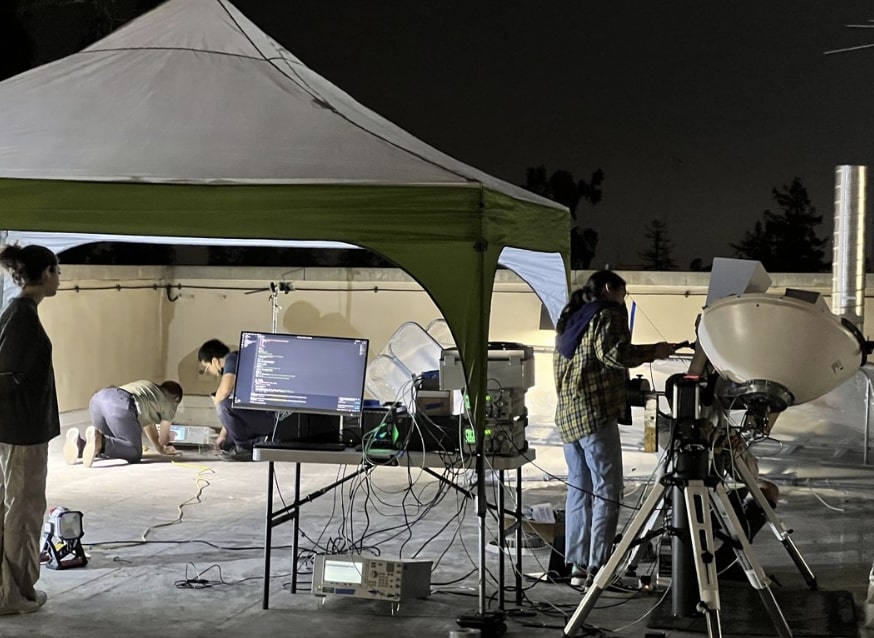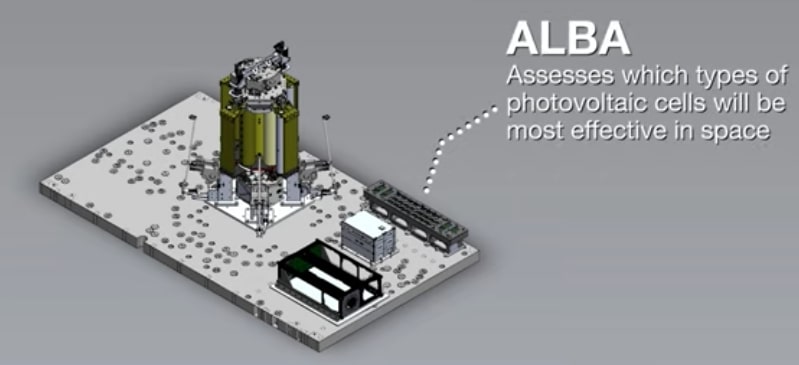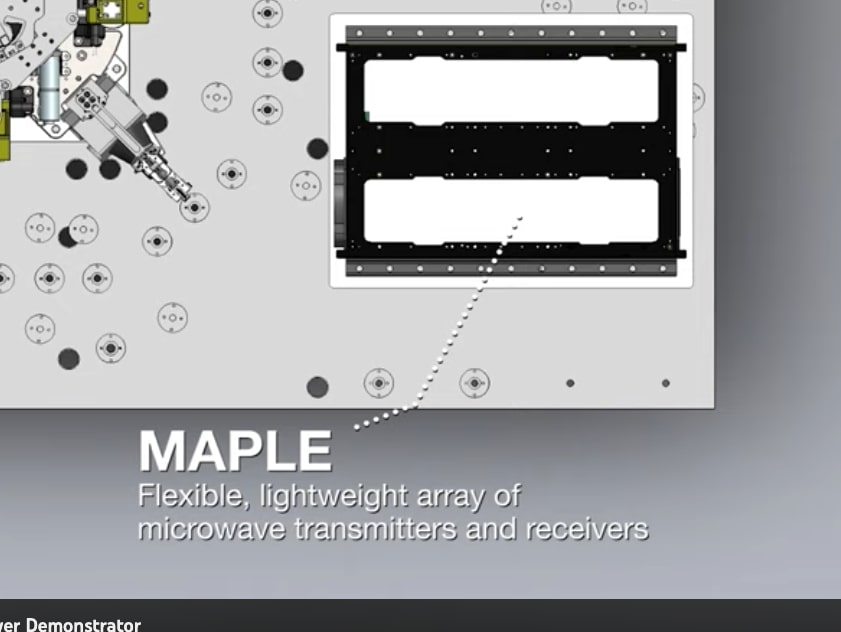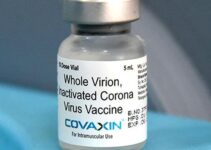Caltech Space Solar Power Project (SSPD) launched into orbit a prototype to beam power to Earth and has transmitted power from orbit to another receiver in orbit. They confirmed that MAPLE can transmit power successfully to receivers in space. They have also been able to program the array to direct its energy toward Earth, which we detected here at Caltech. The system was tested on Earth. They now know it can survive the trip to space and operate there.
MAPLE, short for Microwave Array for Power-transfer Low-orbit Experiment and one of the three key experiments within SSPD-1, consists of an array of flexible lightweight microwave power transmitters driven by custom electronic chips that were built using low-cost silicon technologies. It uses the array of transmitters to beam the energy to desired locations. For SSPP to be feasible, energy transmission arrays will need to be lightweight to minimize the amount of fuel needed to send them to space, flexible so they can fold up into a package that can be transported in a rocket, and a low-cost technology overall.
MAPLE was developed by a Caltech team led by Ali Hajimiri, Bren Professor of Electrical Engineering and Medical Engineering and co-director of SSPP.
MAPLE features two separate receiver arrays located about a foot away from the transmitter to receive the energy, convert it to direct current (DC) electricity, and use it to light up a pair of LEDs to demonstrate the full sequence of wireless energy transmission at a distance in space. MAPLE tested this in space by lighting up each LED individually and shifting back and forth between them. The experiment is not sealed, so it is subject to the harsh environment of space, including the wide temperature swings and solar radiation that will be faced one day by large-scale SSPP units.
MAPLE also includes a small window through which the array can beam the energy. This transmitted energy was detected by a receiver on the roof of the Gordon and Betty Moore Laboratory of Engineering on Caltech’s campus in Pasadena. The received signal appeared at the expected time and frequency, and had the right frequency shift as predicted based on its travel from orbit.

The next steps for the team are to assess the performance of individual elements within the system by evaluating the interference patterns of smaller groups and measuring difference between various combinations. The researchers say the process, which can take up to six months to fully complete, will allow the team to sort out irregularities and trace them back to individual units, providing insight for the next generation of the system.

The SSPD deployed a constellation of modular spacecraft equipped with PV to collect sunlight, convert it to electricity, and then wirelessly transmit the electricity to the ground. Caltech said the technology could be useful to remote areas that do not have supportive transmission infrastructure.
Wireless power transfer was demonstrated by Microwave Array for Power-transfer Low-orbit Experiment (MAPLE), developed at Caltech. It is one of three key technologies being tested by the Space Solar Power Demonstrator (SSPD-1), the first space-borne prototype from Caltech’s SSPP.
MAPLE includes lightweight microwave power transmitters driven by custom electronic chips that were built using low-cost silicon technologies. It uses the array of transmitters to beam the energy to desired locations.
In addition to the $100 million from Donald Brens, Northrop Grumman Corporation also provided Caltech $12.5 million over three years through a sponsored research agreement between 2014 and 2017 that supported for the development of technology and advancement of science for the project.
Future Caltech Design
A future Caltech design will have individual SSPP units will fold up into packages about 1 cubic meter in volume and then unfurl into flat squares about 50 meters per side, with solar cells on one side facing toward the sun and wireless power transmitters on the other side facing toward Earth.
A Momentus Vigoride spacecraft launched aboard a SpaceX rocket on the Transporter-6 mission carried 50-kilogram SSPD to space. Momentus is providing ongoing hosted payload support to Caltech, including providing data, communication, commanding and telemetry, and resources for optimal picture taking and solar cell lighting. The entire set of three prototypes within the SSPD was envisioned, designed, built, and tested by a team of about 35 individuals—faculty, postdocs, graduate students, and undergrads—in labs at Caltech.
SSPD has two main experiments besides MAPLE: DOLCE (Deployable on-Orbit ultraLight Composite Experiment), a structure measuring 6 feet by 6 feet that demonstrates the architecture, packaging scheme, and deployment mechanisms of the modular spacecraft; and ALBA, a collection of 32 different types of photovoltaic cells to enable an assessment of the types of cells that are the most effective in the punishing environment of space. The ALBA tests of solar cells are ongoing, and the SSPP has not yet attempted to deploy DOLCE as of press time. Results from those experiments are expected in the coming months.
img src=”https://nextbigfuture.s3.amazonaws.com/uploads/2023/01/Screen-Shot-2023-01-07-at-10.07.46-AM-1024×585.jpg” alt=”” width=”1024″ height=”585″ class=”alignnone size-large wp-image-178951″ />









A Momentus Vigoride spacecraft was carried aboard a SpaceX rocket on the Transporter-6 mission will carry the 50-kilogram SSPD to space. It consists of three main experiments, each tasked with testing a different key technology of the project:
* DOLCE (Deployable on-Orbit ultraLight Composite Experiment): A structure measuring 6 feet by 6 feet that demonstrates the architecture, packaging scheme and deployment mechanisms of the modular spacecraft that would eventually make up a kilometer-scale constellation forming a power station;
* ALBA: A collection of 32 different types of photovoltaic (PV) cells, to enable an assessment of the types of cells that are the most effective in the punishing environment of space;
* MAPLE (Microwave Array for Power-transfer Low-orbit Experiment): An array of flexible lightweight microwave power transmitters with precise timing control focusing the power selectively on two different receivers to demonstrate wireless power transmission at distance in space.
An additional fourth component of SSPD is a box of electronics that interfaces with the Vigoride computer and controls the three experiments.


Brian Wang is a Futurist Thought Leader and a popular Science blogger with 1 million readers per month. His blog Nextbigfuture.com is ranked #1 Science News Blog. It covers many disruptive technology and trends including Space, Robotics, Artificial Intelligence, Medicine, Anti-aging Biotechnology, and Nanotechnology.
Known for identifying cutting edge technologies, he is currently a Co-Founder of a startup and fundraiser for high potential early-stage companies. He is the Head of Research for Allocations for deep technology investments and an Angel Investor at Space Angels.
A frequent speaker at corporations, he has been a TEDx speaker, a Singularity University speaker and guest at numerous interviews for radio and podcasts. He is open to public speaking and advising engagements.


